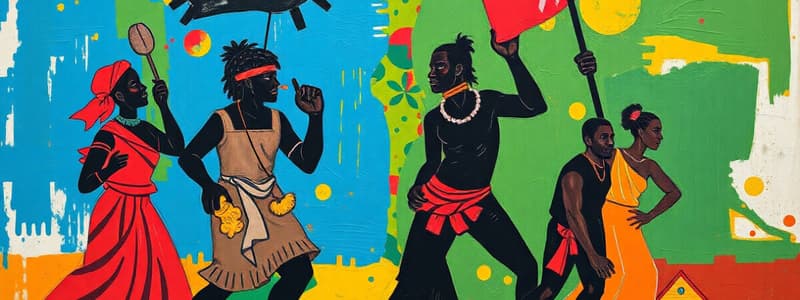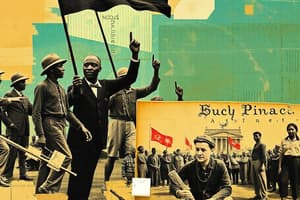Podcast
Questions and Answers
What was a significant social impact of the emergence of a peasant class in the Caribbean?
What was a significant social impact of the emergence of a peasant class in the Caribbean?
- It contributed to the development of rural communities. (correct)
- It weakened the sugar industry's profitability.
- It resulted in the suppression of African traditions.
- It led to increased reliance on plantation labor.
How did the arrival of Indian indentured laborers affect the sugar industry in the Caribbean?
How did the arrival of Indian indentured laborers affect the sugar industry in the Caribbean?
- It caused a significant reduction in the profitability of sugar plantations.
- It led to the immediate decline of sugar production.
- It provided a steady workforce, saving the industry from collapse after emancipation. (correct)
- It resulted in a rise in wages for all workers.
What was a primary way in which the peasantry preserved African traditions in the Caribbean?
What was a primary way in which the peasantry preserved African traditions in the Caribbean?
- By resisting the introduction of new religions and cultural practices.
- By focusing on the production of cash crops for export.
- Through the maintenance of traditional farming techniques and food preparation. (correct)
- Through the adoption of European agricultural practices.
Which of the following is NOT a cultural contribution of Indian immigrants to the Caribbean?
Which of the following is NOT a cultural contribution of Indian immigrants to the Caribbean?
How did the emergence of a peasant class in the Caribbean threaten the profitability of sugar plantations?
How did the emergence of a peasant class in the Caribbean threaten the profitability of sugar plantations?
What was a primary reason for the introduction of Indian indentured labor in the Caribbean?
What was a primary reason for the introduction of Indian indentured labor in the Caribbean?
What was a negative consequence of the availability of indentured laborers in the Caribbean?
What was a negative consequence of the availability of indentured laborers in the Caribbean?
Which of the following is an example of the impact of Indian immigration on Caribbean cuisine?
Which of the following is an example of the impact of Indian immigration on Caribbean cuisine?
What does the phrase "separation from children or family members" refer to in the text?
What does the phrase "separation from children or family members" refer to in the text?
How did the emergence of a peasant class in the Caribbean contribute to a sense of independence among former slaves?
How did the emergence of a peasant class in the Caribbean contribute to a sense of independence among former slaves?
Which form of resistance was primarily used by women in the Caribbean?
Which form of resistance was primarily used by women in the Caribbean?
What was a common form of physical punishment inflicted upon enslaved women?
What was a common form of physical punishment inflicted upon enslaved women?
Which of the following was a key aspect of cultural resistance among enslaved women?
Which of the following was a key aspect of cultural resistance among enslaved women?
What was a primary reason for the differences in forms of resistance between men and women?
What was a primary reason for the differences in forms of resistance between men and women?
Which of the following is NOT a form of resistance commonly used by both men and women?
Which of the following is NOT a form of resistance commonly used by both men and women?
What form of resistance involved escaping plantations and forming independent communities?
What form of resistance involved escaping plantations and forming independent communities?
How did psychological punishment affect enslaved women?
How did psychological punishment affect enslaved women?
Which of the following was a consequence of sexual abuse inflicted upon enslaved women?
Which of the following was a consequence of sexual abuse inflicted upon enslaved women?
What was the primary objective of punishment inflicted upon enslaved women?
What was the primary objective of punishment inflicted upon enslaved women?
What event in the Caribbean is often cited as a successful example of large-scale enslaved resistance?
What event in the Caribbean is often cited as a successful example of large-scale enslaved resistance?
Flashcards
Maroonage
Maroonage
Runaway slaves created communities in the Caribbean, often resisting colonists through guerrilla warfare.
Revolts and Rebellions
Revolts and Rebellions
Organized uprisings by enslaved people, like the 1760 Tacky's Rebellion in Jamaica and the Haitian Revolution.
Sabotage
Sabotage
Enslaved men intentionally damaged plantation machinery or crops to decrease productivity.
Infanticide and Abortions
Infanticide and Abortions
Signup and view all the flashcards
Work Slowdowns
Work Slowdowns
Signup and view all the flashcards
Cultural Resistance
Cultural Resistance
Signup and view all the flashcards
Feigning Illness
Feigning Illness
Signup and view all the flashcards
Religious and Cultural Practices
Religious and Cultural Practices
Signup and view all the flashcards
Running Away
Running Away
Signup and view all the flashcards
Whipping
Whipping
Signup and view all the flashcards
Separation as Punishment
Separation as Punishment
Signup and view all the flashcards
Labor Punishments for Women
Labor Punishments for Women
Signup and view all the flashcards
Impact of Peasantry in the Caribbean
Impact of Peasantry in the Caribbean
Signup and view all the flashcards
Agricultural Diversification in the Caribbean
Agricultural Diversification in the Caribbean
Signup and view all the flashcards
Peasantry's Impact on Sugar Plantations
Peasantry's Impact on Sugar Plantations
Signup and view all the flashcards
Social Impact of Peasantry in the Caribbean
Social Impact of Peasantry in the Caribbean
Signup and view all the flashcards
Self-Reliance and Independence of the Peasantry
Self-Reliance and Independence of the Peasantry
Signup and view all the flashcards
Impact of Indian Immigration on Caribbean Religion
Impact of Indian Immigration on Caribbean Religion
Signup and view all the flashcards
Indian Cuisine's Influence on Caribbean Food
Indian Cuisine's Influence on Caribbean Food
Signup and view all the flashcards
Indian Immigration's Influence on Caribbean Music
Indian Immigration's Influence on Caribbean Music
Signup and view all the flashcards
Study Notes
Slave Resistance in the Caribbean
- Enslaved people resisted slavery actively and passively
- Forms of resistance varied between men and women due to their roles in plantation life
Forms of Resistance by Men
- Maroonage: Escaped slaves formed communities (Maroons) and often waged guerrilla warfare against colonists
- Revolts and Rebellions: Men participated in organized uprisings, such as Tacky's Rebellion and the Haitian Revolution
- Sabotage: Damaged machinery or burned crops to disrupt plantation productivity
Forms of Resistance by Women
- Infanticide and Abortions: Some women killed their newborns or induced abortions to prevent them from being slaves
- Work Slowdowns: Deliberately slowed down work or performed tasks poorly as subtle forms of rebellion
- Cultural Resistance: Women preserved African traditions through storytelling, dance, and music, fostering a sense of identity and resistance
- Shared Resistance Forms: Both men and women pretended to be ill to avoid work, and used religious and cultural practices, as well as running away, as forms of resistance
Punishment of Enslaved Women in the Caribbean
- Punishment was harsh and intended to maintain control
- Women were subjected to physical, psychological, and sexual abuse
- Physical Punishments: Whipping (often public), branding, and mutilation
- Sexual Abuse: Rape and sexual exploitation by overseers and plantation owners
- Psychological Punishment: Public shaming, separation from children or family
Effects of Peasantry in the Caribbean
- The emergence of a peasant class had significant social, economic, and cultural effects
- Economic Effects: Peasants diversified agriculture, growing food crops, reducing reliance on plantation labor, and impacting sugar plantation profitability
- Social Effects: Peasants developed rural communities, established schools, churches, and cooperative societies, fostering independence and self-reliance among former slaves
- Cultural Effects: Peasants preserved African traditions in farming, food preparation, and community life, including resistance to colonial systems
Indian Immigration
- Indian immigration to the Caribbean began in the 19th century to fill labor needs after slavery was abolished
- Impact on the Sugar Industry: Provided a steady workforce, suppressing wages to benefit plantation owners
- Contributions to Caribbean Culture: Introduced Hinduism, Islam, Indian spices, dishes (curry, roti), music (dholak, tassa drums), languages, and farming techniques (rice)
Arguments For and Against Slavery in the British Caribbean
- Arguments For: Slavery was economically necessary for the profitable sugar industry, supported by racial superiority claims and religious justifications for christianizing Africans
- Arguments Against: Slavery was inhumane, a violation of human rights, and economically less efficient. Free labor was a more productive and less expensive alternative. Religious opposition to slavery and political pressure also helped end it.
Studying That Suits You
Use AI to generate personalized quizzes and flashcards to suit your learning preferences.




